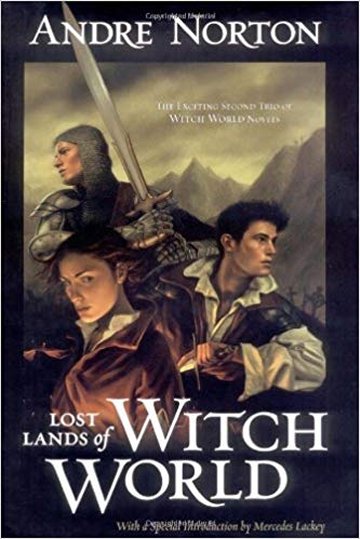
Andre’s fans rejoice in the fact that the Lady has remained with us for so many decades. She was born in the early 20th century and is no longer as young and mobile as she once had been. Although Ms. Norton has remained active in the commissioning and editing of her books for many years, she all but stopped writing original stories herself for several years.
Ms. Norton has helped launch the careers of several successful writers, but younger fans may not be aware that many of the books coming out under Andre’s name were not written by her. In the case of the Witch World, Andre began accepting and approving stories by other writers long before she herself ceased to write. Thus, she imprinted a level of canonicity upon the Witch World which is unusual among science fiction and fantasy authors. Only a few, such as Marion Zimmer Bradley and Jerry Pournelle, have actively invited and collaborated with other authors to contribute stories and build up new characters and histories in their worlds.
The concept of the open world (as opposed to a shared world, which is open to a select group of writers from its inception, such as the Thives World group launched by Robert Lynn Asprin and Lynn Abbey) challenges reader expectations. Those of us who grew up with Andre’s crisp, analytical style received a shock when books began appearing under her name which lacked the polish and sophistication we were used to.
While some readers have made the adjustment to the open world status of Witch World, others have resisted the changeover. Of course, after writing about Witch World and its inhabitants for 25 years, Andre was certainly entitled to a break or even to abandon the project altogether. But she has always been a true visionary in this field, and she felt strongly that other minds and hearts could share stories in the Witch World venue that she herself could not see.
And yet, for the chronicler, professional or amateur, the transition from a proprietary, closed world to an open world presents many challenges. How is canonicity to be established? For example, one day, Andre will no longer be with us. If her estate or publishers elect to maintain the franchise and commission new books, what status should those books be assigned with respect to the books published in Andre’s life time? Even the books which she did not write, she (so far as we know) read, critiqued, and review with her co-authors. At the very least, she exerted some control over those stories.
But those stories are nonetheless tales written by other hands. They often feel very little like a true Andre Norton story. It is very, very difficult for a skilled writer to maintain a specific style which is not his or her own, and Andre has encouraged authors to flourish and discover their own talents. By her very generosity and support, she has therefore perhaps forever closed the chapter of Witch World authorship which flourished under her own hand.
I don’t believe Ms. Norton ever really sat down and wrote out the history of the Witch World in advance. It just sort of grew on her, although eventually she must have compiled quite a few notes. Pauline Griffin tells me that authors who have written Witch World books/stories have been given some guidelines, but I haven’t seen them.
Juanita Coulson has written an official history or timeline for the Witch World. Ms. Norton still hopes to see it published. Since I haven’t seen the book myself, I’m rather skeptical about how consistent it will be with published sources, but who knows? I certainly have made some errors with my own work.
What follows is a collection of fairly old notes which I compiled while in college (in the early 1980s). This is info is by NO MEANS complete or up-to-date, but it takes a lot of time I don’t presently have to compile this information. I have tried, over the last few months, to correct a few points — especially where others have contacted me.
Ethan Merritt has suggested the years may be named through augury, citing a passage from The Jargoon Pard:
“The very names of the years, as they passed, showed that the balance of the Power was a little troubled. For we had behind us such as as the Years of the Lamia, the Chimera, the Harpy and the Orc.. These were signs that the golden peace of my childhood were fading, though the why of this puzzled all who thought about the matter.”
In The Magestone it appears that Alizon was settled before Estcarp. Two Adepts, Elsenar and Shorrosh, opened a gate to the world called Aliz and brought some of their people through (to save them). When Elsenar discovered that Shorrosh was a dark Adept he closed the gate on Shorrosh. While Elsenar was busy with the Alizonders, the Old Race abandoned Escore, raising the mountains and establishing Lormt as a fortress against the dark Adepts. This information conflicts with the account given in Three Against The Witch World and its companion books Warlock of the Witch World and Sorceress of the Witch World. Although there are numerous discrepancies of detail in the books, this strikes me as a major blunder but I’m not sure of how it got into the storyline. Ms. Norton, I am told, carefully reviews each of the collaborations and edits them.
Let it suffice to say that presently there are huge discrepancies, IMHO introduced by Ms. Norton’s collaborators. I may at some point in time try to reconcile them as best I can.